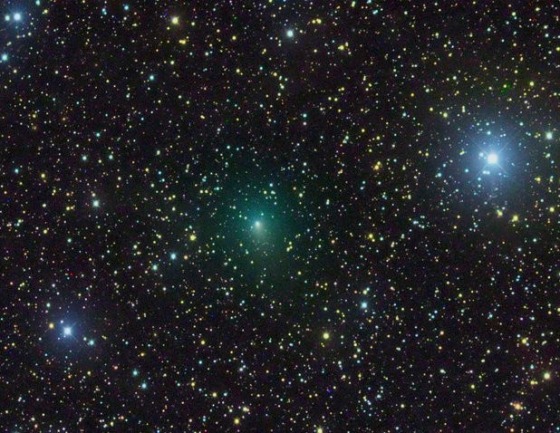Comet Hartley 2 is looming larger in a space probe's field of view, and in the cameras of earthbound stargazers as well. But there are even better views to come, on Earth and in the heavens. Soon you can even see it for yourself. The comet's close approach ranks as one of the stargazing highlights of the year, as well as a highlight for NASA's EPOXI mission. The probe's acronym actually super-glues two abbreviations together: EPOCh (Extrasolar Planet Obervation and Characterization) plus DIXI (Deep Impact eXtended Investigation). Comet 103P/Hartley 2 is the star of the DIXI part of the show. On Nov. 4, the recommissioned Deep Impact spacecraft will come within 450 miles (700 kilometers)of the half-mile-wide (kilometer-wide) comet.
NASA / JPL / UM Red lines point to Comet Hartley 2 in the EPOXI mission's first picture of its target.
EPOXI's first picture of the gassy, dirty snowball came in last week, and another one was posted just today. You can follow the flow of mission data day by day via @cometexplorer's Twitter updates. But right now, Hartley 2 looks like little more than a fuzzy smudge amid the background stars. Earthly observers are getting nicer pictures and posting them to EPOXI's Facebook page. The color pictures show the comet surrounded by an eerie greenish glow. British astrophotographer Nick Howes assembled his black-and-white images into a video that tracks Hartley 2 through the night sky: Just as EPOXI is coming closer to Hartley 2, Hartley 2 is coming closer to Earth with every passing day. Sky & Telescope's Greg Bryant says the comet should reach magnitude 5 or 6 in the constellation Cassiopeia by early October. Usually that would be bright enough for naked-eye observing under optimal conditions. "But it's important to note that ... its light is no longer concentrated into a small dot but instead is more spread out. So even if you can sight a 6th-magnitude star with the unaided eye, Hartley 2 will be tougher," Bryant writes. Oct. 7 should be about the peak time for comet-watching, in part because there won't be any competing glare from the moon. In the Northern Hemisphere, binoculars and small telescopes should bring Hartley 2 into view — if you know where to look. Sky & Telescope's diagram pinpoints the comet's location as it moves across the sky. You can also feast your eyes on the cometary imagery popping up on Facebook and the University of Maryland's Amateur Observers' Gallery, as well as on Gary W. Kronk's Cometography website and at the Lowell Observatory.
Photo by Gary W. Kronk Comet Hartley 2 shines in a picture taken by Gary Kronk from his observatory in Illinois on Sept. 12.
The Planetary Society's Emily Lakdawalla notes that EPOXI's camera doesn't have the resolving power that Earth-based cameras do, and that's one reason why the telescopic images are better now. (Another reason is that Earth is currently closer to Hartley 2 than EPOXI is, due to the spacecraft's looping trajectory.) All that will change as EPOXI closes in for its encounter and sends back not just dozens of images, but tens of thousands of images. "Space cameras eventually take better pictures of targets because they get much closer to them," Lakdawalla says. I can hardly wait. Join the Cosmic Log corps by signing up as my Facebook friend or hooking up on Twitter. And if you really want to be friendly, ask me about "The Case forPluto."
